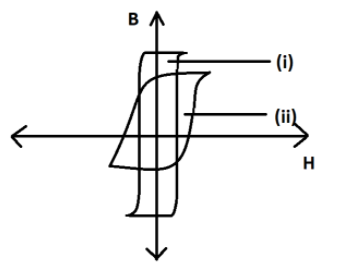
The B-H curve shown in the fig. associated with

A). (i) diamagnetic and (ii) paramagnetic substance
B). (i) paramagnetic and (ii) ferromagnetic substance
C). (i) soft iron and (ii) steel respectively
D). (i) steel and (ii) soft iron respectively

Answer
492k+ views
Hint: The diagram shown in the figure represents the behaviour of a material taken through a cycle of magnetization. We need to study the property of retentivity and coercivity from the hysteresis loop that are given on the Y and X axis respectively.
Complete step by step answer:
The figure shows the hysteresis loop that represents the Magnetic field induction (B) on the Y-axis and magnetizing force (H) on the X-axis.
The value of magnetic field induction left in the specimen when the magnetising force is reduced to zero is called Retentivity of the material and it is seen on the Y-axis. To reduce the retentivity to zero we need to apply a magnetizing force in the opposite direction. This value of magnetising force is called the coercivity of the material and it is on the X- axis.
The retentivity of soft iron is greater than the retentivity of steel as it gets more strongly magnetised than steel. Also, soft iron loses its magnetism more rapidly than steel so its coercivity is less than that of steel. Accordingly, it can be seen from the figure that (i) represents soft iron and (ii) is steel.
Hence, the correct answer is option C. (i) soft iron and (ii) steel respectively.
Note: The students must remember that the area of B-H curve represents hysteresis loss. Note that hysteresis loss in case of soft iron is much less than the hysteresis loss due to steel. Steel and Iron are both ferromagnetic materials so options A , B are not correct.
Complete step by step answer:
The figure shows the hysteresis loop that represents the Magnetic field induction (B) on the Y-axis and magnetizing force (H) on the X-axis.
The value of magnetic field induction left in the specimen when the magnetising force is reduced to zero is called Retentivity of the material and it is seen on the Y-axis. To reduce the retentivity to zero we need to apply a magnetizing force in the opposite direction. This value of magnetising force is called the coercivity of the material and it is on the X- axis.
The retentivity of soft iron is greater than the retentivity of steel as it gets more strongly magnetised than steel. Also, soft iron loses its magnetism more rapidly than steel so its coercivity is less than that of steel. Accordingly, it can be seen from the figure that (i) represents soft iron and (ii) is steel.
Hence, the correct answer is option C. (i) soft iron and (ii) steel respectively.
Note: The students must remember that the area of B-H curve represents hysteresis loss. Note that hysteresis loss in case of soft iron is much less than the hysteresis loss due to steel. Steel and Iron are both ferromagnetic materials so options A , B are not correct.
Recently Updated Pages
Master Class 12 English: Engaging Questions & Answers for Success

Master Class 12 Business Studies: Engaging Questions & Answers for Success

Master Class 12 Social Science: Engaging Questions & Answers for Success

Master Class 12 Chemistry: Engaging Questions & Answers for Success

Class 12 Question and Answer - Your Ultimate Solutions Guide

Master Class 12 Economics: Engaging Questions & Answers for Success

Trending doubts
What is the Full Form of PVC, PET, HDPE, LDPE, PP and PS ?

Draw a neat and well labeled diagram of TS of ovary class 12 biology CBSE

In fibre optics the signal source is waves A Light class 12 physics CBSE

What is shunt Explain its uses class 12 physics CBSE

The artificial sweetener that has the highest sweetness class 12 chemistry CBSE

A convex lens is placed in water Its focal length A class 12 physics CBSE




